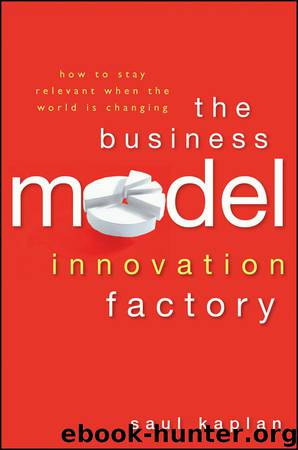The Business Model Innovation Factory by Saul Kaplan

Author:Saul Kaplan
Language: eng
Format: mobi, epub
Publisher: John Wiley & Sons, Ltd.
Published: 2012-03-14T21:00:00+00:00
Principle 13. Off the Whiteboard and into the Real World
Move quickly from the theoretical to the actual. Real-world change has more variables than you can anticipate. Experimentation yields rich results.
It is easy to sketch out business model innovation scenarios on the whiteboard. It is far more difficult to take the idea off the whiteboard for a spin in the real world. We need safe and manageable platforms for real-world experimentation of new business models and social systems. Since most leaders in the twenty-first century will likely have to change their business models several times over their careers it makes sense to do R&D for new business models the same way R&D is done for new products and technologies today. Create the space for exploration. We need to create the conditions in the real world for ongoing experimentation of new business models and social systems.
If organizations of all kinds need to experiment with new business models in the real world and communities need to become more relevant in order to strengthen their local economies, here's an idea: Why not turn cities into innovation hot spots or platforms to enable ongoing experimentation of new business models and social systems? It would create the conditions for public and private sector organizations to continually explore new business models, while at the same time helping communities access new solutions and a stronger local economy for its citizens. Sounds like a win-win scenario to me.
In 2010 I participated in an Economic Development Roundtable in Detroit providing a perfect forum to float the idea. Before going to the event, participants were asked to answer the following question:
Given your experience, what are the most “game-changing” ways to use a significant amount of grant funding ($100 million+) to change the trajectory of an urban economy? In other words, if you were given a free hand to use $100 million+ of grants, what would you do?
Here is how I answered: I suggest that we turn cities into innovation hotspots. We need a new national economic development conversation. It should bubble up from cities. We are playing defense based on old industrial economy rules and systems. We must play offense to create a twenty-first century innovation economy that all citizens can fully participate in. An innovation economy will provide citizens with a viable job ladder and good higher wage job opportunities. It will also enable solutions for the big system challenges we face including health care, education, workforce development, and energy sustainability. These are system challenges that will not be fixed with incremental tweaks. We must design, demonstrate, and deploy new system approaches to these challenges. The solutions should be coming from our cities. Cities should be living labs. If cities become innovation hot spots, new investment and jobs will be created. We need ongoing R&D for new transformative models and systems. Developing a twenty-first century innovation economy depends on it.
The good news is that given the scope of economic challenges our cities face, there is more receptivity to innovation than ever.
Download
The Business Model Innovation Factory by Saul Kaplan.epub
This site does not store any files on its server. We only index and link to content provided by other sites. Please contact the content providers to delete copyright contents if any and email us, we'll remove relevant links or contents immediately.
Bad Blood by John Carreyrou(6510)
Rich Dad Poor Dad by Robert T. Kiyosaki(6342)
Principles: Life and Work by Ray Dalio(6160)
Playing to Win_ How Strategy Really Works by A.G. Lafley & Roger L. Martin(5811)
Management Strategies for the Cloud Revolution: How Cloud Computing Is Transforming Business and Why You Can't Afford to Be Left Behind by Charles Babcock(4505)
The Confidence Code by Katty Kay(4170)
Thinking in Bets by Annie Duke(4132)
American Kingpin by Nick Bilton(3730)
Delivering Happiness by Tony Hsieh(3348)
Project Animal Farm: An Accidental Journey into the Secret World of Farming and the Truth About Our Food by Sonia Faruqi(3154)
The Power of Habit by Charles Duhigg(3039)
The Tyranny of Metrics by Jerry Z. Muller(2969)
Brotopia by Emily Chang(2969)
Mastering Bitcoin: Programming the Open Blockchain by Andreas M. Antonopoulos(2964)
The Marketing Plan Handbook: Develop Big-Picture Marketing Plans for Pennies on the Dollar by Robert W. Bly(2921)
I Live in the Future & Here's How It Works by Nick Bilton(2914)
The Content Trap by Bharat Anand(2846)
Applied Empathy by Michael Ventura(2823)
Building a StoryBrand by Donald Miller(2822)
